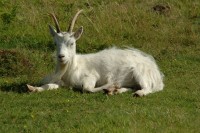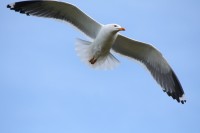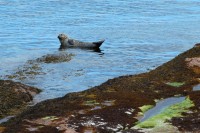Wildlife on the Island
 At present, there are three types of large mammals living on Holy Isle: the Eriskay ponies, Soay sheep and Saanen goats.
At present, there are three types of large mammals living on Holy Isle: the Eriskay ponies, Soay sheep and Saanen goats.
Both the ponies and the sheep were introduced by the UFAW (Universities Federation for Animal Welfare) when they owned the island, the goats are believed to have been here for many centuries.
Lama Yeshe has given the animals the chance to establish their own behaviour patterns without human interference, both within their own group and between the different groups. They have settled into herds and live in peaceful co-existence with each other. Undisturbed by people, they have no fear of humans, and live in harmony on the island. People are asked not to feed or disturb the animals.
Apart from the mammals introduced by humans, there are many birds and a wide variety of sea life. Read a little about the trees and different flora naturally found on the island.
Eriskay ponies
Eriskay ponies are the last surviving remnants of the original native ponies from the Hebridean Isle of Eriskay (south of South Uist), and have ancient Celtic and Norse origins. The ponies are a hardy breed with their dense and waterproof coat, enabling them to live comfortably in the Scottish climate all year round. Often they are born black or bay and turn grey, and later white, as they grow older. Usually, the ponies spend their time on the plateaus of the hills or on the fields at the south end, but they regularly graze the fields surrounding the Centre. As an unsuspecting visitor you can suddenly find yourself surrounded by a quietly grazing herd, undisturbed by human presence. They don't seem to be afraid of humans at all, though usually they walk away when we come within a few feet of them. The young ones are often inquisitive, and skittish, one moment nuzzling an offered hand, and dashing away the next.
Usually, the ponies spend their time on the plateaus of the hills or on the fields at the south end, but they regularly graze the fields surrounding the Centre. As an unsuspecting visitor you can suddenly find yourself surrounded by a quietly grazing herd, undisturbed by human presence. They don't seem to be afraid of humans at all, though usually they walk away when we come within a few feet of them. The young ones are often inquisitive, and skittish, one moment nuzzling an offered hand, and dashing away the next.
The situation of the ponies on Holy Isle seems to be unique in the world. They are living a free and wild life, and find their own balance in how they live together. This also gives us a rare opportunity to see them living naturally without human interference or demands. People from different animal welfare groups say that the herd looks very healthy and that there is plenty of grazing for them.
Over the years, Lama Yeshe has observed how after a period of unrest and fighting, the ponies seem now to have settled into three groups: one with the main stallion surrounded by a group of females and young ones; another with a female pony as "boss" among older horses; and a small group of young males. In the last years there has hardly been any fighting.
Lama Yeshe would very much welcome any experts who would like to study this unique situation.
Soay sheep
 The ancient breed of Soay sheep has existed in isolation for a long time. They are found in the Outer Hebrides on two of the three main islands of St Kilda: Hirta and Soay. The latter island, Soay, is Norse for "sheep", and gives the breed their name. No one knows how or when the sheep arrived on St Kilda, though archaeological evidence suggests that they have been there since the Bronze Age. Soay sheep are similar to the Mediterranean mouflon, a species of wild sheep thought to be one of the two ancestors for all domesticated sheep. The existence of the sheep on St Kilda suggests that there may have been contact between people in Scotland and south Europe as early as during the Bronze Age.
The ancient breed of Soay sheep has existed in isolation for a long time. They are found in the Outer Hebrides on two of the three main islands of St Kilda: Hirta and Soay. The latter island, Soay, is Norse for "sheep", and gives the breed their name. No one knows how or when the sheep arrived on St Kilda, though archaeological evidence suggests that they have been there since the Bronze Age. Soay sheep are similar to the Mediterranean mouflon, a species of wild sheep thought to be one of the two ancestors for all domesticated sheep. The existence of the sheep on St Kilda suggests that there may have been contact between people in Scotland and south Europe as early as during the Bronze Age.
Soay is also famous for being one of the least visited islands in the world. It has no natural harbour and a 360 degree circle of cliffs. As a result of this isolation and the difficult environment in which they evolved, Soay sheep are naturally very hardy animals and are not dependent on people for anything. Often people who see them grazing on Holy Isle in the distance wonder if they are looking at deer, for they are smaller and more elegant than domesticated sheep, dark brown in colour with a whitish belly. They are one of only three breeds that don't have to be sheared.
Saanen goats
 The white goats with the impressive horns and almost smiling expression on their faces, are of the Saanen-type. No one knows exactly how long they have been on the island, but local knowledge estimates about 700 years. People from the UFAW believed that they were originally brought here by the Vikings, who had a habit of leaving livestock on the Western islands as living food supply that could be called upon during later visits to the area.
The white goats with the impressive horns and almost smiling expression on their faces, are of the Saanen-type. No one knows exactly how long they have been on the island, but local knowledge estimates about 700 years. People from the UFAW believed that they were originally brought here by the Vikings, who had a habit of leaving livestock on the Western islands as living food supply that could be called upon during later visits to the area. Over the decades the numbers of the goats have varied due to natural causes such as weather, available grazing, illnesses, and human intervention like taking some animals off the island, and, prior to Rokpa Trust being the island's caretakers, shooting and culling. At the moment, there are a few dozen goats on the island, wandering around mostly on the east side. Just before the birthing period, which usually starts in early February, the group divides up into males and females, and they don't join again until the start of the next breeding season later in the year.
Over the decades the numbers of the goats have varied due to natural causes such as weather, available grazing, illnesses, and human intervention like taking some animals off the island, and, prior to Rokpa Trust being the island's caretakers, shooting and culling. At the moment, there are a few dozen goats on the island, wandering around mostly on the east side. Just before the birthing period, which usually starts in early February, the group divides up into males and females, and they don't join again until the start of the next breeding season later in the year.
Birds
Holy Isle provides habitat for many species of birds. There are 20-25 species of birds breeding on the island, ranging from the eider ducks, hiding their nests in the bracken and heather beside the shore, and the oyster-catchers and ringed plovers, breeding on the stony shore below the Centre, to the three species of gulls (herring, lesser black-backed, and common) on the rocky slopes and ungrazed grass at the north end. There are snipe, meadow and rock pipits on the island slopes and shores; stonechats and wrens in the heather and bracken; and many woodland and hedgerow birds like chaffinches, greenfinches, blackbirds, song thrushes, robins, willow warblers, blue tits, great tits and cole tits, as well as wood pigeons. As the island is devel oping more woodland, new birds like reed buntings, redpolls and siskins are beginning to turn up, breeding in the larger trees around the Centre. Cuckoos, wood peckers and barn owls also appear at the north end.
oping more woodland, new birds like reed buntings, redpolls and siskins are beginning to turn up, breeding in the larger trees around the Centre. Cuckoos, wood peckers and barn owls also appear at the north end.
Groups of cormorants, and their smaller relatives, the shags, are often found on the shore in the south and east of the island, standing with their wings unfolded to let them dry after their underwater adventures. Fulmars are nesting in the sandstone cliffs on the east side of the island. Around the island in the late summer we see gannets plummet from a great height into the water to catch their fish. They breed in large numbers on neighbouring island Ailsa Craig, which is a nature reserve, and the second largest gannet breeding colony in the world. Other birds spotted in passing are the occasional shearwater, shelduck, and various other ducks (mallard, red-breasted merganser), and wading birds such as curlew and redshank. There have also been sightings of peregrines, ravens, and even an osprey and a hen harrier.
Sea life
 Holy Isle lies in the Firth of Clyde, which is the most southerly fjord in the Northern Hemisphere. The Scottish seas are home to over 8000 species of spectacular underwater life and have a rich biological diversity. Common and grey seals can sometimes be spotted swimming around, curiously looking at what happens on the shore. They also sometimes lie on the jetty or on the big, flat rock on the shore at the very north end of the island, thus called Seal Rock. A group of seals is sometimes heard singing on the rocks at the south end. It's always worth looking out for porpoises and bottlenose dolphins, as well as the 5 tonne basking sharks who are mostly spotted in autumn, and even the very occasional minke whale.
Holy Isle lies in the Firth of Clyde, which is the most southerly fjord in the Northern Hemisphere. The Scottish seas are home to over 8000 species of spectacular underwater life and have a rich biological diversity. Common and grey seals can sometimes be spotted swimming around, curiously looking at what happens on the shore. They also sometimes lie on the jetty or on the big, flat rock on the shore at the very north end of the island, thus called Seal Rock. A group of seals is sometimes heard singing on the rocks at the south end. It's always worth looking out for porpoises and bottlenose dolphins, as well as the 5 tonne basking sharks who are mostly spotted in autumn, and even the very occasional minke whale.
At present, the "Community Of Arran Seabed Trust" has proposed to the Scottish Assembly that the whole of Lamlash Bay become a marine reserve, consisting of a "No Take Zone" and a Marine Protected Area. The Holy Isle Project is very much supporting their initiative.
Trees
 There are 25 different species of trees growing on Holy Isle, ranging from the magnificent oaks and beeches around the garden at the north end of the island, to the small willows and hawthorns, whitebeams, rockbeams, and hazelnut trees which are an indicator of mineral rich soils (brown earths or forest soils). Aspen, whose leaves shake in the slightest breeze, grow at the north end, along with elms, wild cherry, holly and 5 species of willow.In the next few years there are plans to plant trees at the south side of the island as well. In about ten years or so, when the trees at the north end are tall enough not to be damaged by the horses and goats, the fences will be taken down to open up the tree areas.
There are 25 different species of trees growing on Holy Isle, ranging from the magnificent oaks and beeches around the garden at the north end of the island, to the small willows and hawthorns, whitebeams, rockbeams, and hazelnut trees which are an indicator of mineral rich soils (brown earths or forest soils). Aspen, whose leaves shake in the slightest breeze, grow at the north end, along with elms, wild cherry, holly and 5 species of willow.In the next few years there are plans to plant trees at the south side of the island as well. In about ten years or so, when the trees at the north end are tall enough not to be damaged by the horses and goats, the fences will be taken down to open up the tree areas.
Flora
The geological structure of Holy Isle, together with the wild winds and salt-spray, limits the number of species able to survive here. Most of the island's flora consists of heather, bracken and grassland. In total, there are approximately 200 different species of flora on the island, which is good for its size. The greatest abundance of plant species, outside of the cultivated gardens, is found in a ring just above sea level. Species include primroses, bluebells, pale butterwort (an insectivorous plant), sea-radish, quaking grass, bog pimpernel, thrift (sea-pink), bog myrtle, wood anemone, 14 species of sedge, bugle, sea centaury, lady's bedstraw, two St. John's worts, yellow pimpernel, wild strawberry and barren strawberry, blueberry, field pansy, wild thyme and corn spurrey. Bearberry, rare for this part of Scotland, grows on the south-east slopes.
